Uber Case Analysis Report - Innovation at Uber, Semester 1, 2024
VerifiedAdded on 2021/02/20
|20
|4768
|43
Report
AI Summary
This report presents a comprehensive analysis of Uber Technologies Inc., focusing on its operations within the ride-sharing industry. It begins with an external analysis, identifying the industry and examining the general environment, including economic, demographic, socio-cultural, technological, political/legal, and global factors influencing Uber's business. The report utilizes Porter's Five Forces model to assess the competitive landscape, evaluating the threat of new entrants, the bargaining power of buyers and suppliers, the threat of substitute products, and the intensity of rivalry. An internal analysis then assesses Uber's tangible and intangible resources, including financial, organizational, physical, and technological resources, as well as human and reputational assets. The report further examines Uber's capabilities, such as its rapid product iteration and technological advantages, and its ability to adapt to diverse market demands. The analysis draws on the case study "Innovation at Uber: The Launch of Express POOL" and provides insights into Uber's strategies, market dynamics, and competitive positioning.
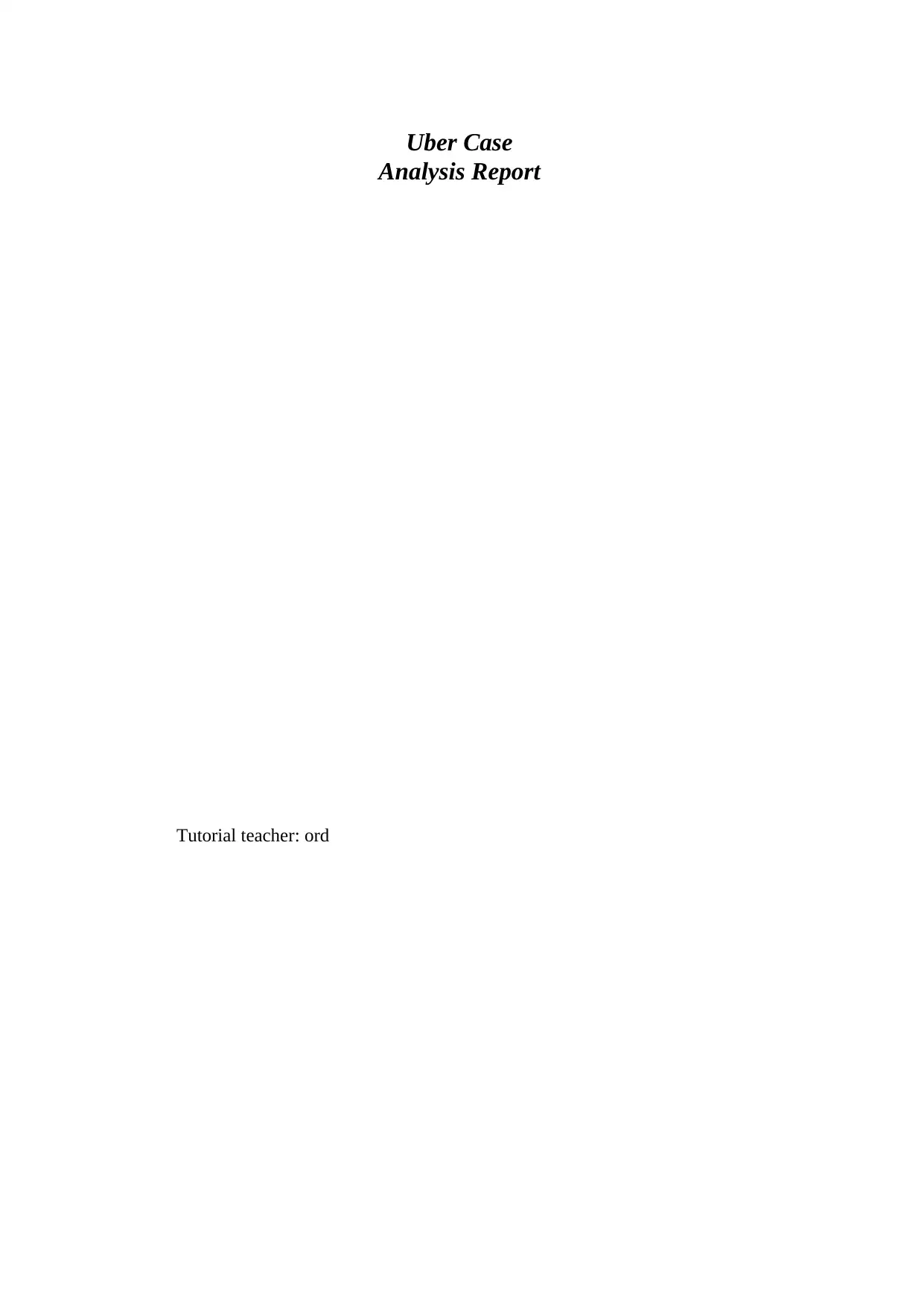
Uber Case
Analysis Report
Tutorial teacher: ord
Analysis Report
Tutorial teacher: ord
Paraphrase This Document
Need a fresh take? Get an instant paraphrase of this document with our AI Paraphraser
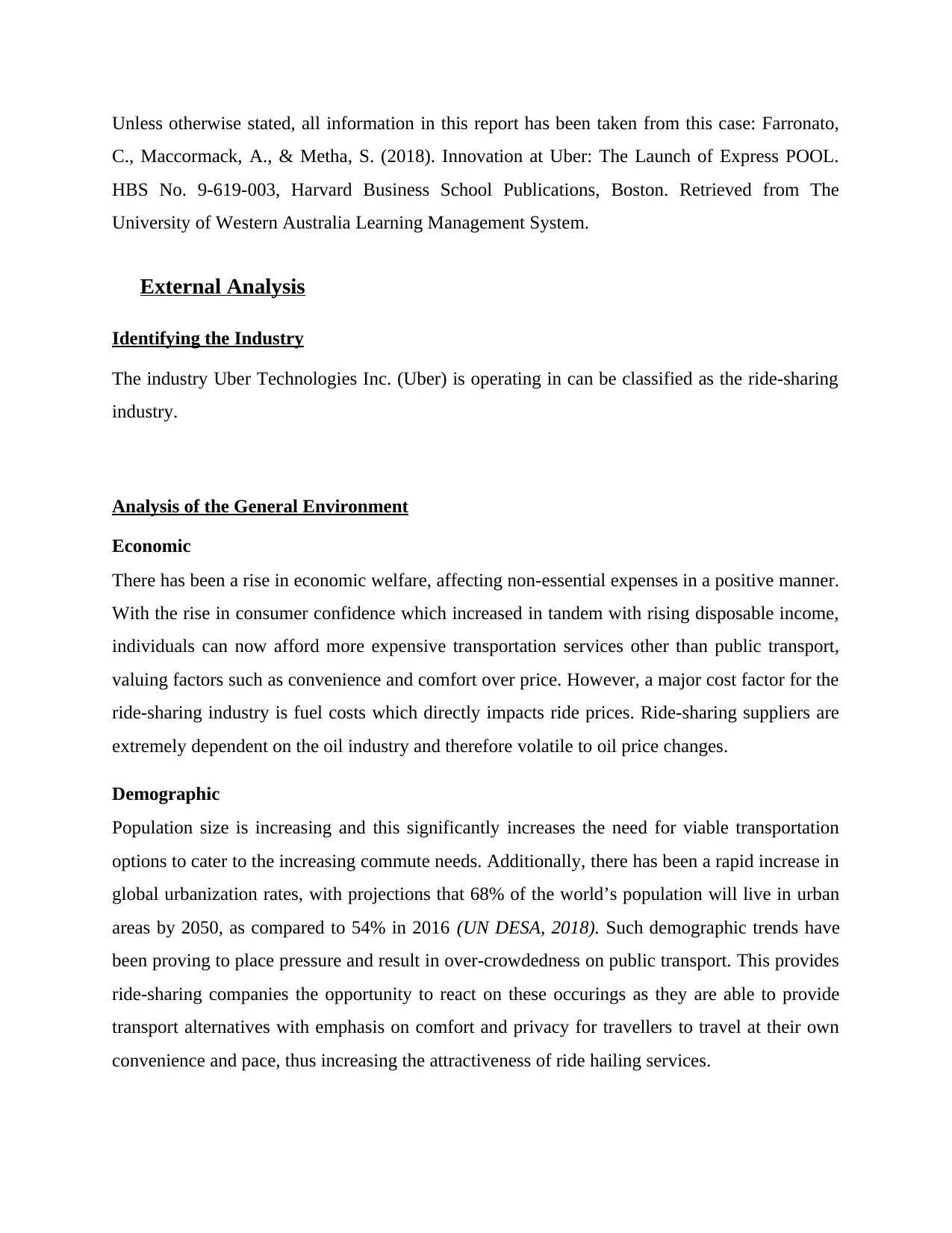
Unless otherwise stated, all information in this report has been taken from this case: Farronato,
C., Maccormack, A., & Metha, S. (2018). Innovation at Uber: The Launch of Express POOL.
HBS No. 9-619-003, Harvard Business School Publications, Boston. Retrieved from The
University of Western Australia Learning Management System.
External Analysis
Identifying the Industry
The industry Uber Technologies Inc. (Uber) is operating in can be classified as the ride-sharing
industry.
Analysis of the General Environment
Economic
There has been a rise in economic welfare, affecting non-essential expenses in a positive manner.
With the rise in consumer confidence which increased in tandem with rising disposable income,
individuals can now afford more expensive transportation services other than public transport,
valuing factors such as convenience and comfort over price. However, a major cost factor for the
ride-sharing industry is fuel costs which directly impacts ride prices. Ride-sharing suppliers are
extremely dependent on the oil industry and therefore volatile to oil price changes.
Demographic
Population size is increasing and this significantly increases the need for viable transportation
options to cater to the increasing commute needs. Additionally, there has been a rapid increase in
global urbanization rates, with projections that 68% of the world’s population will live in urban
areas by 2050, as compared to 54% in 2016 (UN DESA, 2018). Such demographic trends have
been proving to place pressure and result in over-crowdedness on public transport. This provides
ride-sharing companies the opportunity to react on these occurings as they are able to provide
transport alternatives with emphasis on comfort and privacy for travellers to travel at their own
convenience and pace, thus increasing the attractiveness of ride hailing services.
C., Maccormack, A., & Metha, S. (2018). Innovation at Uber: The Launch of Express POOL.
HBS No. 9-619-003, Harvard Business School Publications, Boston. Retrieved from The
University of Western Australia Learning Management System.
External Analysis
Identifying the Industry
The industry Uber Technologies Inc. (Uber) is operating in can be classified as the ride-sharing
industry.
Analysis of the General Environment
Economic
There has been a rise in economic welfare, affecting non-essential expenses in a positive manner.
With the rise in consumer confidence which increased in tandem with rising disposable income,
individuals can now afford more expensive transportation services other than public transport,
valuing factors such as convenience and comfort over price. However, a major cost factor for the
ride-sharing industry is fuel costs which directly impacts ride prices. Ride-sharing suppliers are
extremely dependent on the oil industry and therefore volatile to oil price changes.
Demographic
Population size is increasing and this significantly increases the need for viable transportation
options to cater to the increasing commute needs. Additionally, there has been a rapid increase in
global urbanization rates, with projections that 68% of the world’s population will live in urban
areas by 2050, as compared to 54% in 2016 (UN DESA, 2018). Such demographic trends have
been proving to place pressure and result in over-crowdedness on public transport. This provides
ride-sharing companies the opportunity to react on these occurings as they are able to provide
transport alternatives with emphasis on comfort and privacy for travellers to travel at their own
convenience and pace, thus increasing the attractiveness of ride hailing services.
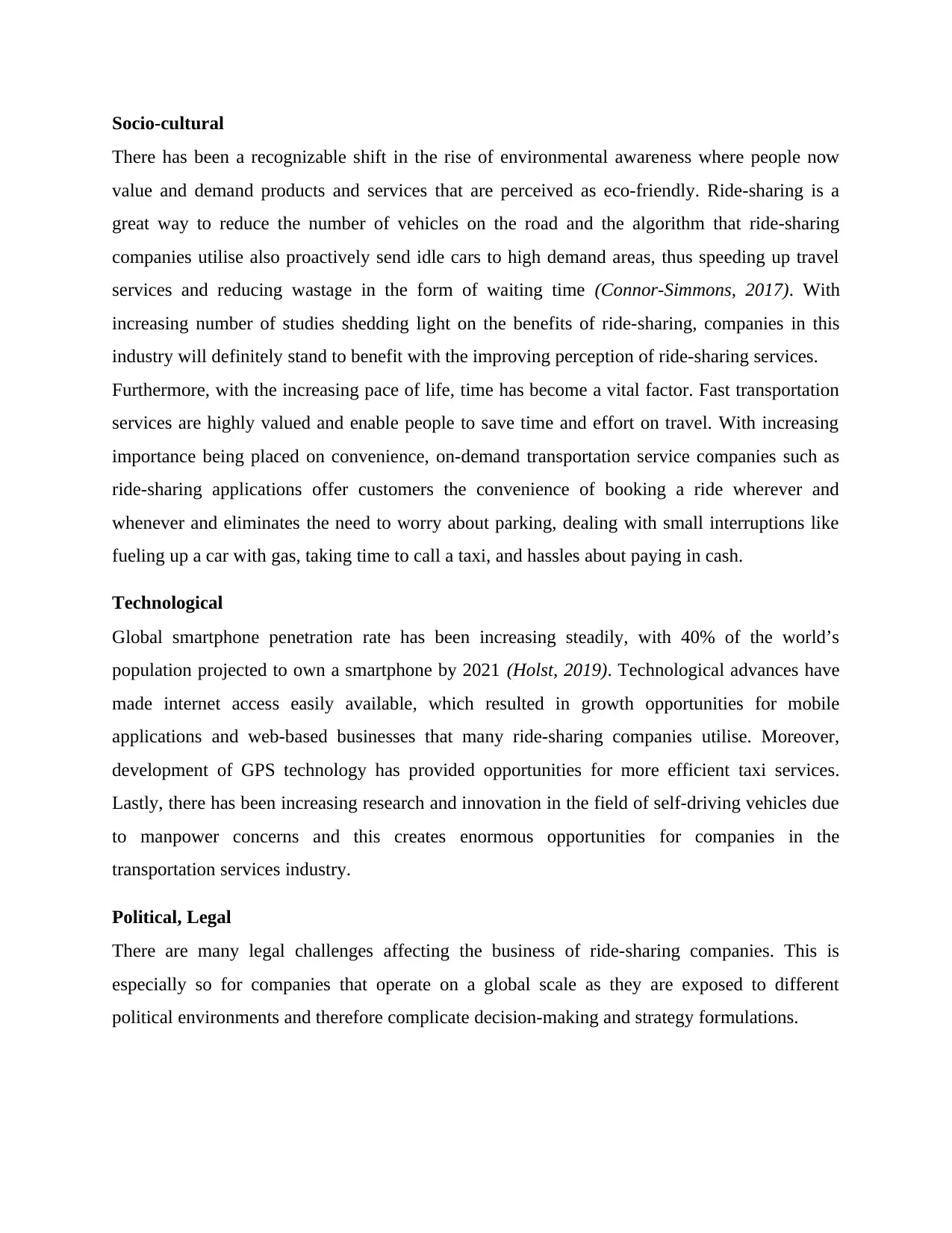
Socio-cultural
There has been a recognizable shift in the rise of environmental awareness where people now
value and demand products and services that are perceived as eco-friendly. Ride-sharing is a
great way to reduce the number of vehicles on the road and the algorithm that ride-sharing
companies utilise also proactively send idle cars to high demand areas, thus speeding up travel
services and reducing wastage in the form of waiting time (Connor-Simmons, 2017). With
increasing number of studies shedding light on the benefits of ride-sharing, companies in this
industry will definitely stand to benefit with the improving perception of ride-sharing services.
Furthermore, with the increasing pace of life, time has become a vital factor. Fast transportation
services are highly valued and enable people to save time and effort on travel. With increasing
importance being placed on convenience, on-demand transportation service companies such as
ride-sharing applications offer customers the convenience of booking a ride wherever and
whenever and eliminates the need to worry about parking, dealing with small interruptions like
fueling up a car with gas, taking time to call a taxi, and hassles about paying in cash.
Technological
Global smartphone penetration rate has been increasing steadily, with 40% of the world’s
population projected to own a smartphone by 2021 (Holst, 2019). Technological advances have
made internet access easily available, which resulted in growth opportunities for mobile
applications and web-based businesses that many ride-sharing companies utilise. Moreover,
development of GPS technology has provided opportunities for more efficient taxi services.
Lastly, there has been increasing research and innovation in the field of self-driving vehicles due
to manpower concerns and this creates enormous opportunities for companies in the
transportation services industry.
Political, Legal
There are many legal challenges affecting the business of ride-sharing companies. This is
especially so for companies that operate on a global scale as they are exposed to different
political environments and therefore complicate decision-making and strategy formulations.
There has been a recognizable shift in the rise of environmental awareness where people now
value and demand products and services that are perceived as eco-friendly. Ride-sharing is a
great way to reduce the number of vehicles on the road and the algorithm that ride-sharing
companies utilise also proactively send idle cars to high demand areas, thus speeding up travel
services and reducing wastage in the form of waiting time (Connor-Simmons, 2017). With
increasing number of studies shedding light on the benefits of ride-sharing, companies in this
industry will definitely stand to benefit with the improving perception of ride-sharing services.
Furthermore, with the increasing pace of life, time has become a vital factor. Fast transportation
services are highly valued and enable people to save time and effort on travel. With increasing
importance being placed on convenience, on-demand transportation service companies such as
ride-sharing applications offer customers the convenience of booking a ride wherever and
whenever and eliminates the need to worry about parking, dealing with small interruptions like
fueling up a car with gas, taking time to call a taxi, and hassles about paying in cash.
Technological
Global smartphone penetration rate has been increasing steadily, with 40% of the world’s
population projected to own a smartphone by 2021 (Holst, 2019). Technological advances have
made internet access easily available, which resulted in growth opportunities for mobile
applications and web-based businesses that many ride-sharing companies utilise. Moreover,
development of GPS technology has provided opportunities for more efficient taxi services.
Lastly, there has been increasing research and innovation in the field of self-driving vehicles due
to manpower concerns and this creates enormous opportunities for companies in the
transportation services industry.
Political, Legal
There are many legal challenges affecting the business of ride-sharing companies. This is
especially so for companies that operate on a global scale as they are exposed to different
political environments and therefore complicate decision-making and strategy formulations.
⊘ This is a preview!⊘
Do you want full access?
Subscribe today to unlock all pages.

Trusted by 1+ million students worldwide
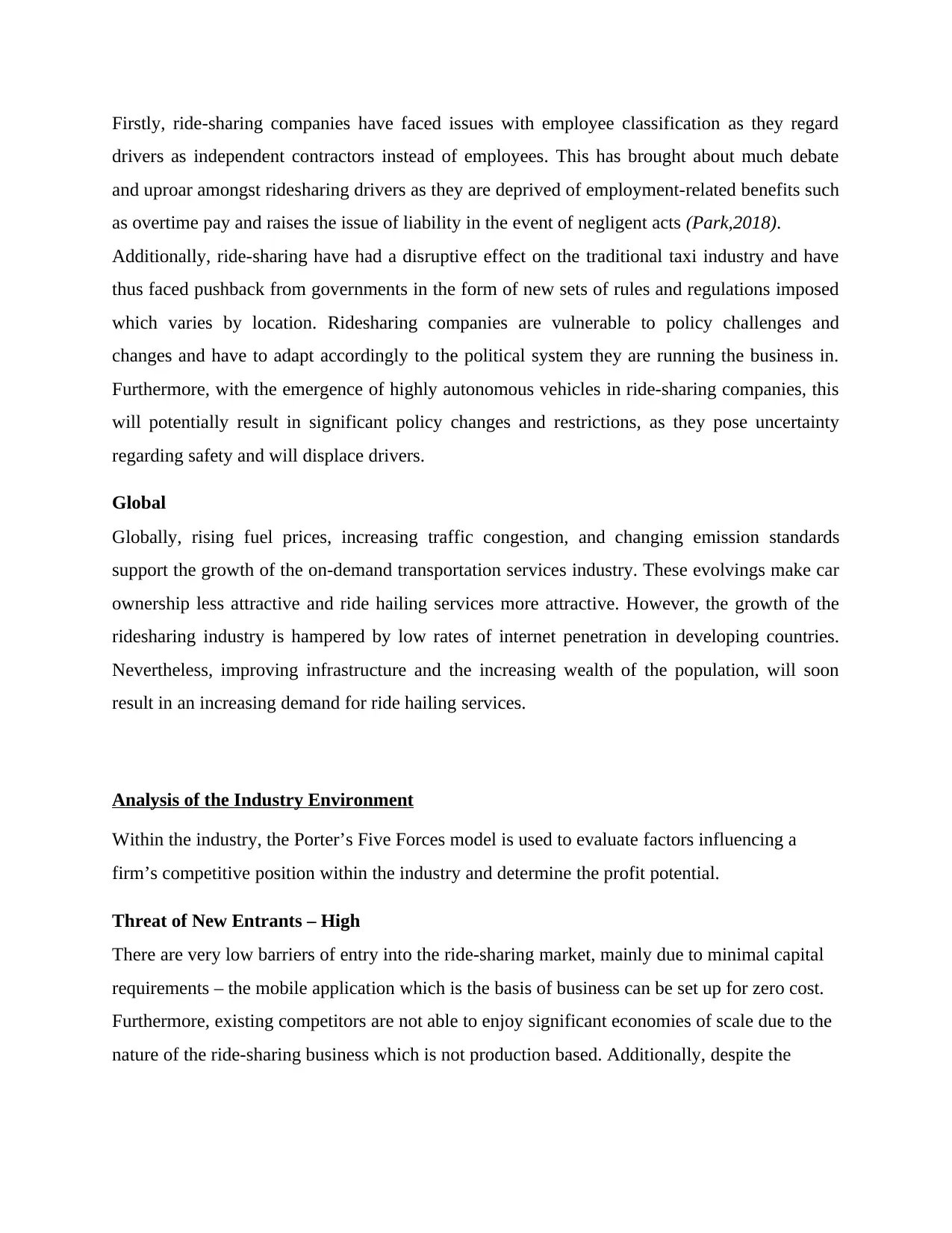
Firstly, ride-sharing companies have faced issues with employee classification as they regard
drivers as independent contractors instead of employees. This has brought about much debate
and uproar amongst ridesharing drivers as they are deprived of employment-related benefits such
as overtime pay and raises the issue of liability in the event of negligent acts (Park,2018).
Additionally, ride-sharing have had a disruptive effect on the traditional taxi industry and have
thus faced pushback from governments in the form of new sets of rules and regulations imposed
which varies by location. Ridesharing companies are vulnerable to policy challenges and
changes and have to adapt accordingly to the political system they are running the business in.
Furthermore, with the emergence of highly autonomous vehicles in ride-sharing companies, this
will potentially result in significant policy changes and restrictions, as they pose uncertainty
regarding safety and will displace drivers.
Global
Globally, rising fuel prices, increasing traffic congestion, and changing emission standards
support the growth of the on-demand transportation services industry. These evolvings make car
ownership less attractive and ride hailing services more attractive. However, the growth of the
ridesharing industry is hampered by low rates of internet penetration in developing countries.
Nevertheless, improving infrastructure and the increasing wealth of the population, will soon
result in an increasing demand for ride hailing services.
Analysis of the Industry Environment
Within the industry, the Porter’s Five Forces model is used to evaluate factors influencing a
firm’s competitive position within the industry and determine the profit potential.
Threat of New Entrants – High
There are very low barriers of entry into the ride-sharing market, mainly due to minimal capital
requirements – the mobile application which is the basis of business can be set up for zero cost.
Furthermore, existing competitors are not able to enjoy significant economies of scale due to the
nature of the ride-sharing business which is not production based. Additionally, despite the
drivers as independent contractors instead of employees. This has brought about much debate
and uproar amongst ridesharing drivers as they are deprived of employment-related benefits such
as overtime pay and raises the issue of liability in the event of negligent acts (Park,2018).
Additionally, ride-sharing have had a disruptive effect on the traditional taxi industry and have
thus faced pushback from governments in the form of new sets of rules and regulations imposed
which varies by location. Ridesharing companies are vulnerable to policy challenges and
changes and have to adapt accordingly to the political system they are running the business in.
Furthermore, with the emergence of highly autonomous vehicles in ride-sharing companies, this
will potentially result in significant policy changes and restrictions, as they pose uncertainty
regarding safety and will displace drivers.
Global
Globally, rising fuel prices, increasing traffic congestion, and changing emission standards
support the growth of the on-demand transportation services industry. These evolvings make car
ownership less attractive and ride hailing services more attractive. However, the growth of the
ridesharing industry is hampered by low rates of internet penetration in developing countries.
Nevertheless, improving infrastructure and the increasing wealth of the population, will soon
result in an increasing demand for ride hailing services.
Analysis of the Industry Environment
Within the industry, the Porter’s Five Forces model is used to evaluate factors influencing a
firm’s competitive position within the industry and determine the profit potential.
Threat of New Entrants – High
There are very low barriers of entry into the ride-sharing market, mainly due to minimal capital
requirements – the mobile application which is the basis of business can be set up for zero cost.
Furthermore, existing competitors are not able to enjoy significant economies of scale due to the
nature of the ride-sharing business which is not production based. Additionally, despite the
Paraphrase This Document
Need a fresh take? Get an instant paraphrase of this document with our AI Paraphraser

saturation in the market for ride-share, customers are price sensitive and rarely stay loyal to a
single company, switching to whomever that offers the lowest price.
Bargaining power of buyers – High
Buyers are mainly individual customers seeking for transportation options and they are presented
with a myriad of modes to choose from other than booking a ride-share such as public
transportation, flagging a traditional taxi, driving, cycling and even walking if deemed possible.
Thus, the bargaining power of buyers are high as there is a plethora of product offerings that
fulfil the same purpose of transporting customers to their desired destination.
Bargaining power of suppliers – High
Suppliers are the drivers that ride-share companies contract with, to provide the actual
chauffeuring service. There is low switching cost for providers (drivers) as they are able to
utilize multiple platforms with ease and the amount of “supply” they provide in the form of rides
are flexible, with no specific quota (Uber Blog, 2016).
Threat of substitute products – High
There are a fair number of substitutes in the ride-share industry that fulfils the same needs of
customers, which is essentially to get to their desired locations. Depending on the customer’s
preference such as comfort and price points, the services that ride-share companies provide are
easily substitutable. Furthermore, the existence of a credible substitute product such as traditional
taxis, creates price limits for the services that ride-share companies provide.
Intensity of Rivalry – High
There is a high level of rivalry in the market due to the high concentration of competitors.
Additionally, the ride-sharing market is anticipated to grow continuously at a growth rate of
more than 20% over the period of 2018 to 2025 (Costello, 2019). With such a high and steady
growth in the ride-sharing market, this will attract even more competitors to enter in the future.
The large number of existing and potential competitors, coupled with low switching cost for
customers due to minimal differentiation in the services provided across different ride-sharing
service providers, intensity of rivalry is very high.
single company, switching to whomever that offers the lowest price.
Bargaining power of buyers – High
Buyers are mainly individual customers seeking for transportation options and they are presented
with a myriad of modes to choose from other than booking a ride-share such as public
transportation, flagging a traditional taxi, driving, cycling and even walking if deemed possible.
Thus, the bargaining power of buyers are high as there is a plethora of product offerings that
fulfil the same purpose of transporting customers to their desired destination.
Bargaining power of suppliers – High
Suppliers are the drivers that ride-share companies contract with, to provide the actual
chauffeuring service. There is low switching cost for providers (drivers) as they are able to
utilize multiple platforms with ease and the amount of “supply” they provide in the form of rides
are flexible, with no specific quota (Uber Blog, 2016).
Threat of substitute products – High
There are a fair number of substitutes in the ride-share industry that fulfils the same needs of
customers, which is essentially to get to their desired locations. Depending on the customer’s
preference such as comfort and price points, the services that ride-share companies provide are
easily substitutable. Furthermore, the existence of a credible substitute product such as traditional
taxis, creates price limits for the services that ride-share companies provide.
Intensity of Rivalry – High
There is a high level of rivalry in the market due to the high concentration of competitors.
Additionally, the ride-sharing market is anticipated to grow continuously at a growth rate of
more than 20% over the period of 2018 to 2025 (Costello, 2019). With such a high and steady
growth in the ride-sharing market, this will attract even more competitors to enter in the future.
The large number of existing and potential competitors, coupled with low switching cost for
customers due to minimal differentiation in the services provided across different ride-sharing
service providers, intensity of rivalry is very high.
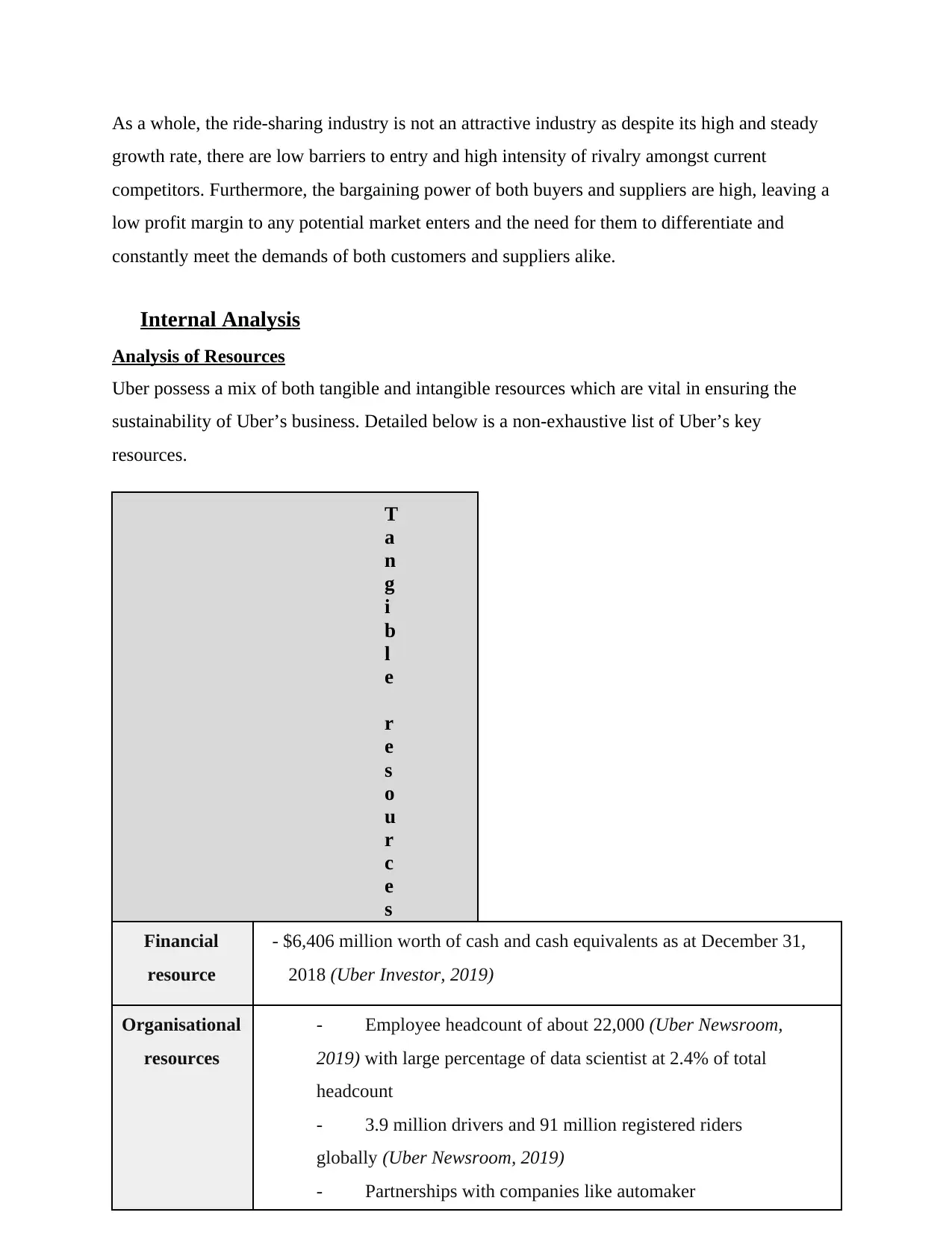
As a whole, the ride-sharing industry is not an attractive industry as despite its high and steady
growth rate, there are low barriers to entry and high intensity of rivalry amongst current
competitors. Furthermore, the bargaining power of both buyers and suppliers are high, leaving a
low profit margin to any potential market enters and the need for them to differentiate and
constantly meet the demands of both customers and suppliers alike.
Internal Analysis
Analysis of Resources
Uber possess a mix of both tangible and intangible resources which are vital in ensuring the
sustainability of Uber’s business. Detailed below is a non-exhaustive list of Uber’s key
resources.
T
a
n
g
i
b
l
e
r
e
s
o
u
r
c
e
s
Financial
resource
- $6,406 million worth of cash and cash equivalents as at December 31,
2018 (Uber Investor, 2019)
Organisational
resources
- Employee headcount of about 22,000 (Uber Newsroom,
2019) with large percentage of data scientist at 2.4% of total
headcount
- 3.9 million drivers and 91 million registered riders
globally (Uber Newsroom, 2019)
- Partnerships with companies like automaker
growth rate, there are low barriers to entry and high intensity of rivalry amongst current
competitors. Furthermore, the bargaining power of both buyers and suppliers are high, leaving a
low profit margin to any potential market enters and the need for them to differentiate and
constantly meet the demands of both customers and suppliers alike.
Internal Analysis
Analysis of Resources
Uber possess a mix of both tangible and intangible resources which are vital in ensuring the
sustainability of Uber’s business. Detailed below is a non-exhaustive list of Uber’s key
resources.
T
a
n
g
i
b
l
e
r
e
s
o
u
r
c
e
s
Financial
resource
- $6,406 million worth of cash and cash equivalents as at December 31,
2018 (Uber Investor, 2019)
Organisational
resources
- Employee headcount of about 22,000 (Uber Newsroom,
2019) with large percentage of data scientist at 2.4% of total
headcount
- 3.9 million drivers and 91 million registered riders
globally (Uber Newsroom, 2019)
- Partnerships with companies like automaker
⊘ This is a preview!⊘
Do you want full access?
Subscribe today to unlock all pages.

Trusted by 1+ million students worldwide
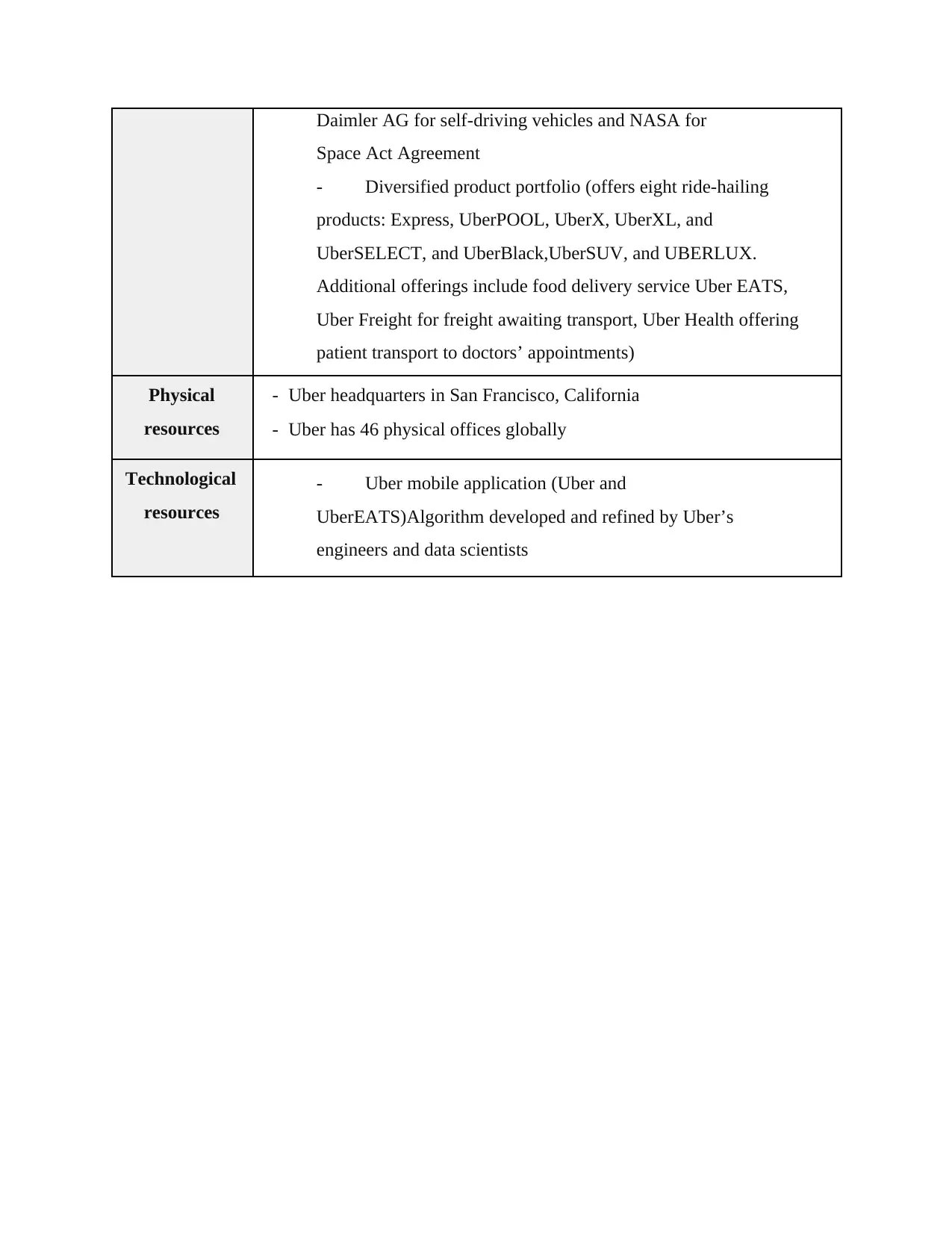
Daimler AG for self-driving vehicles and NASA for
Space Act Agreement
- Diversified product portfolio (offers eight ride-hailing
products: Express, UberPOOL, UberX, UberXL, and
UberSELECT, and UberBlack,UberSUV, and UBERLUX.
Additional offerings include food delivery service Uber EATS,
Uber Freight for freight awaiting transport, Uber Health offering
patient transport to doctors’ appointments)
Physical
resources
- Uber headquarters in San Francisco, California
- Uber has 46 physical offices globally
Technological
resources
- Uber mobile application (Uber and
UberEATS)Algorithm developed and refined by Uber’s
engineers and data scientists
Space Act Agreement
- Diversified product portfolio (offers eight ride-hailing
products: Express, UberPOOL, UberX, UberXL, and
UberSELECT, and UberBlack,UberSUV, and UBERLUX.
Additional offerings include food delivery service Uber EATS,
Uber Freight for freight awaiting transport, Uber Health offering
patient transport to doctors’ appointments)
Physical
resources
- Uber headquarters in San Francisco, California
- Uber has 46 physical offices globally
Technological
resources
- Uber mobile application (Uber and
UberEATS)Algorithm developed and refined by Uber’s
engineers and data scientists
Paraphrase This Document
Need a fresh take? Get an instant paraphrase of this document with our AI Paraphraser
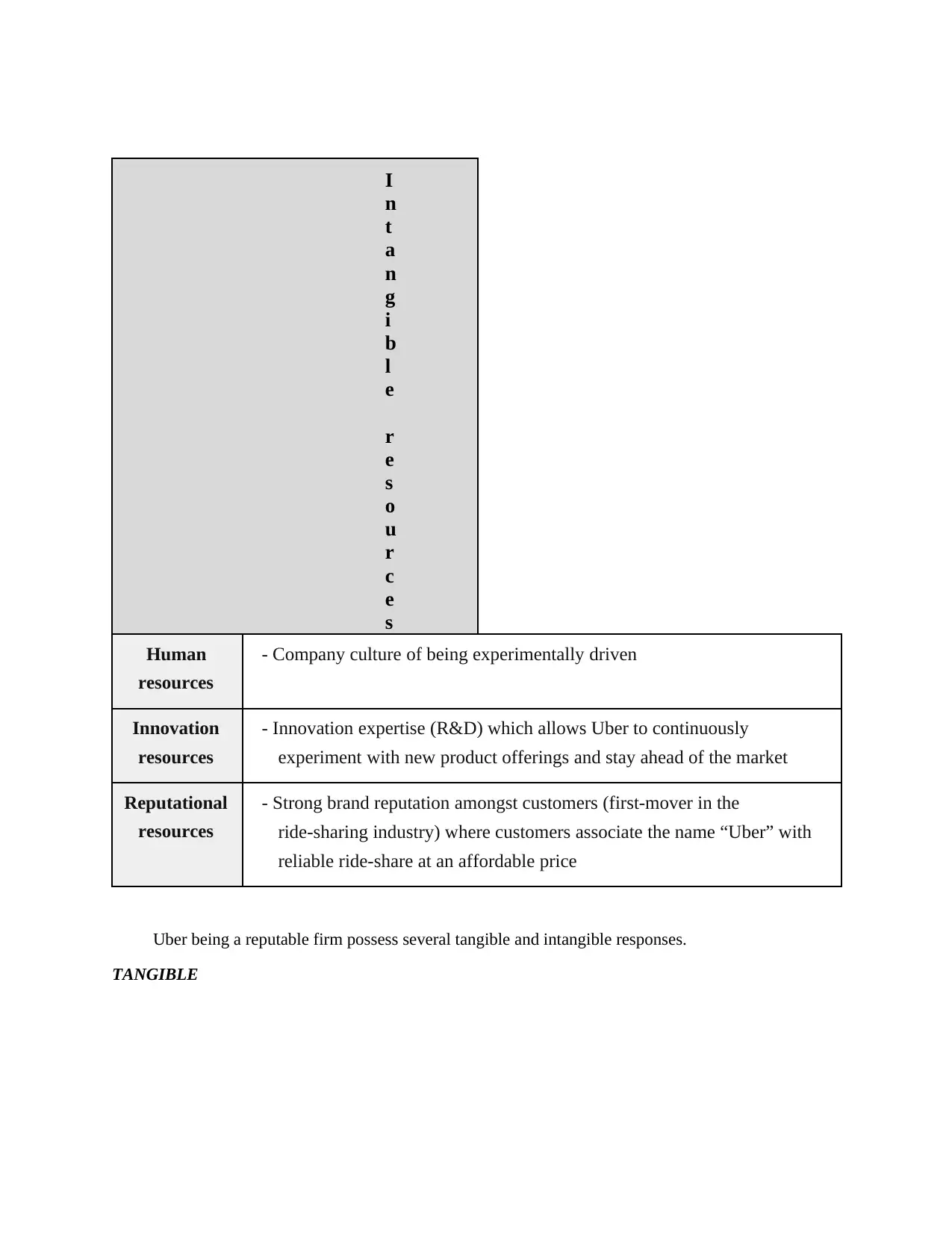
I
n
t
a
n
g
i
b
l
e
r
e
s
o
u
r
c
e
s
Human
resources
- Company culture of being experimentally driven
Innovation
resources
- Innovation expertise (R&D) which allows Uber to continuously
experiment with new product offerings and stay ahead of the market
Reputational
resources
- Strong brand reputation amongst customers (first-mover in the
ride-sharing industry) where customers associate the name “Uber” with
reliable ride-share at an affordable price
Uber being a reputable firm possess several tangible and intangible responses.
TANGIBLE
n
t
a
n
g
i
b
l
e
r
e
s
o
u
r
c
e
s
Human
resources
- Company culture of being experimentally driven
Innovation
resources
- Innovation expertise (R&D) which allows Uber to continuously
experiment with new product offerings and stay ahead of the market
Reputational
resources
- Strong brand reputation amongst customers (first-mover in the
ride-sharing industry) where customers associate the name “Uber” with
reliable ride-share at an affordable price
Uber being a reputable firm possess several tangible and intangible responses.
TANGIBLE

⊘ This is a preview!⊘
Do you want full access?
Subscribe today to unlock all pages.

Trusted by 1+ million students worldwide
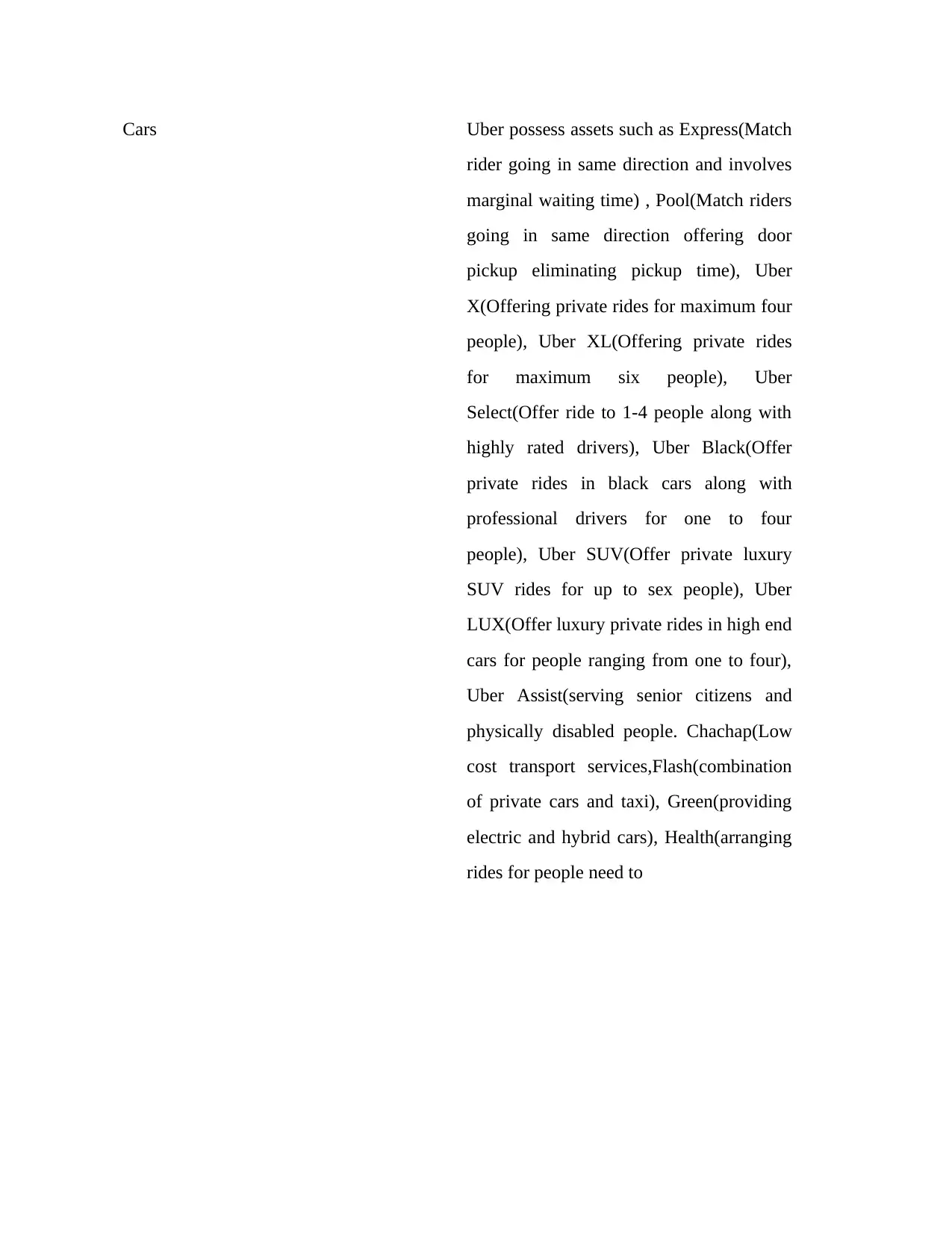
Cars Uber possess assets such as Express(Match
rider going in same direction and involves
marginal waiting time) , Pool(Match riders
going in same direction offering door
pickup eliminating pickup time), Uber
X(Offering private rides for maximum four
people), Uber XL(Offering private rides
for maximum six people), Uber
Select(Offer ride to 1-4 people along with
highly rated drivers), Uber Black(Offer
private rides in black cars along with
professional drivers for one to four
people), Uber SUV(Offer private luxury
SUV rides for up to sex people), Uber
LUX(Offer luxury private rides in high end
cars for people ranging from one to four),
Uber Assist(serving senior citizens and
physically disabled people. Chachap(Low
cost transport services,Flash(combination
of private cars and taxi), Green(providing
electric and hybrid cars), Health(arranging
rides for people need to
rider going in same direction and involves
marginal waiting time) , Pool(Match riders
going in same direction offering door
pickup eliminating pickup time), Uber
X(Offering private rides for maximum four
people), Uber XL(Offering private rides
for maximum six people), Uber
Select(Offer ride to 1-4 people along with
highly rated drivers), Uber Black(Offer
private rides in black cars along with
professional drivers for one to four
people), Uber SUV(Offer private luxury
SUV rides for up to sex people), Uber
LUX(Offer luxury private rides in high end
cars for people ranging from one to four),
Uber Assist(serving senior citizens and
physically disabled people. Chachap(Low
cost transport services,Flash(combination
of private cars and taxi), Green(providing
electric and hybrid cars), Health(arranging
rides for people need to
Paraphrase This Document
Need a fresh take? Get an instant paraphrase of this document with our AI Paraphraser

INTANGIBLE
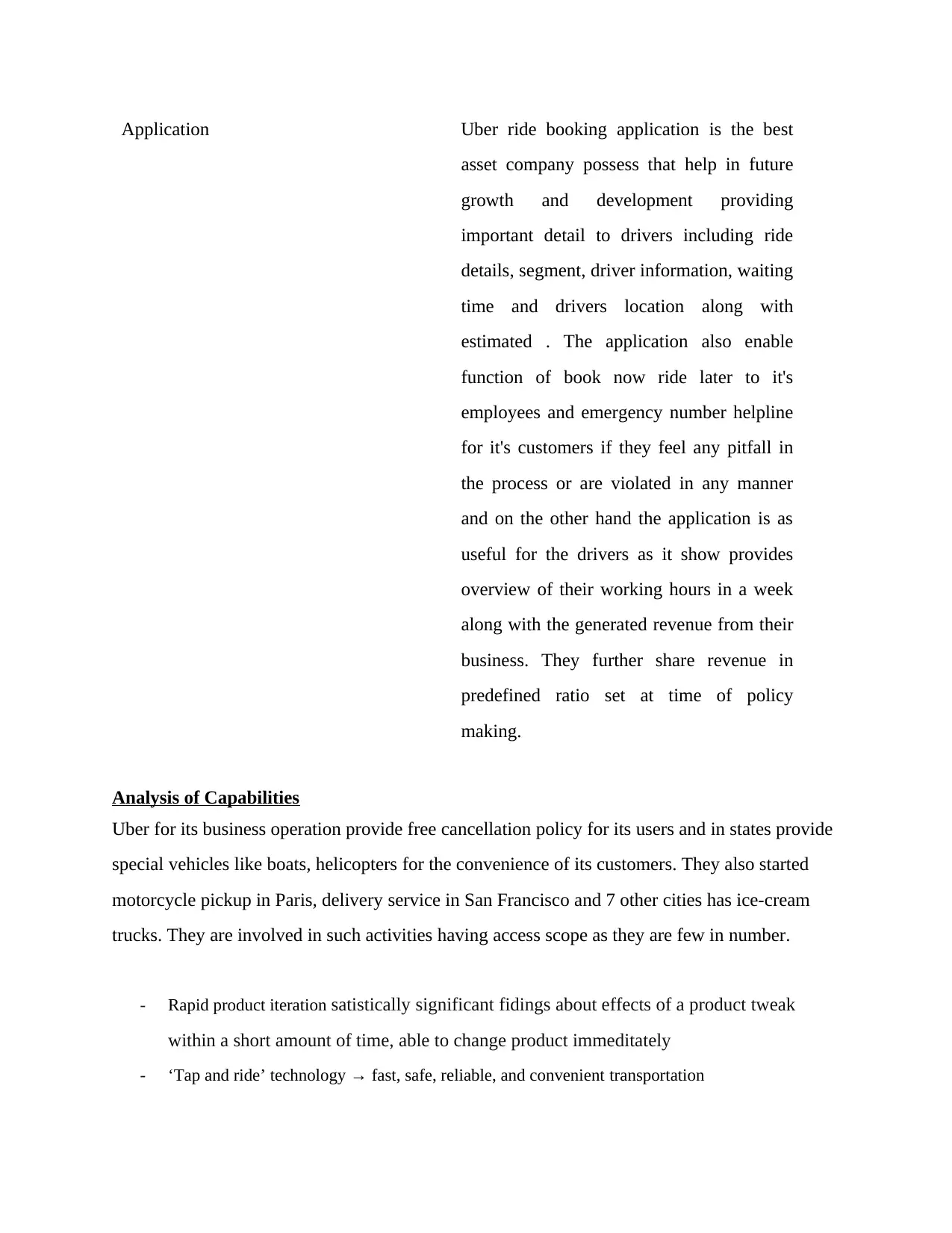
Application Uber ride booking application is the best
asset company possess that help in future
growth and development providing
important detail to drivers including ride
details, segment, driver information, waiting
time and drivers location along with
estimated . The application also enable
function of book now ride later to it's
employees and emergency number helpline
for it's customers if they feel any pitfall in
the process or are violated in any manner
and on the other hand the application is as
useful for the drivers as it show provides
overview of their working hours in a week
along with the generated revenue from their
business. They further share revenue in
predefined ratio set at time of policy
making.
Analysis of Capabilities
Uber for its business operation provide free cancellation policy for its users and in states provide
special vehicles like boats, helicopters for the convenience of its customers. They also started
motorcycle pickup in Paris, delivery service in San Francisco and 7 other cities has ice-cream
trucks. They are involved in such activities having access scope as they are few in number.
- Rapid product iteration satistically significant fidings about effects of a product tweak
within a short amount of time, able to change product immeditately
- ‘Tap and ride’ technology → fast, safe, reliable, and convenient transportation
asset company possess that help in future
growth and development providing
important detail to drivers including ride
details, segment, driver information, waiting
time and drivers location along with
estimated . The application also enable
function of book now ride later to it's
employees and emergency number helpline
for it's customers if they feel any pitfall in
the process or are violated in any manner
and on the other hand the application is as
useful for the drivers as it show provides
overview of their working hours in a week
along with the generated revenue from their
business. They further share revenue in
predefined ratio set at time of policy
making.
Analysis of Capabilities
Uber for its business operation provide free cancellation policy for its users and in states provide
special vehicles like boats, helicopters for the convenience of its customers. They also started
motorcycle pickup in Paris, delivery service in San Francisco and 7 other cities has ice-cream
trucks. They are involved in such activities having access scope as they are few in number.
- Rapid product iteration satistically significant fidings about effects of a product tweak
within a short amount of time, able to change product immeditately
- ‘Tap and ride’ technology → fast, safe, reliable, and convenient transportation
⊘ This is a preview!⊘
Do you want full access?
Subscribe today to unlock all pages.

Trusted by 1+ million students worldwide
1 out of 20
Related Documents
Your All-in-One AI-Powered Toolkit for Academic Success.
+13062052269
info@desklib.com
Available 24*7 on WhatsApp / Email
![[object Object]](/_next/static/media/star-bottom.7253800d.svg)
Unlock your academic potential
Copyright © 2020–2025 A2Z Services. All Rights Reserved. Developed and managed by ZUCOL.





